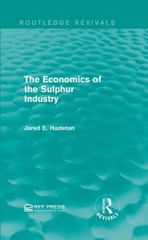Question
Robinson Crusoe is the sole inhabitant of an uncharted island. In this paradise, Robinson's only scarce commodities are food and leisure. The only scarce resource
Robinson Crusoe is the sole inhabitant of an uncharted island. In this paradise, Robinson's only scarce commodities are food and leisure. The only scarce resource is his labor. Use the following notation:
X = quantity of food P = price per unit of food Y = quantity of leisure hours W = wage rate (per hour) L = 24 - Y = labor hours G = profit
As a consumer, Robinson has a utility function U(X,Y) expressing his preferences between food and leisure. As a firm Robinson can transform his labor hours into food according to the production function X = f(L).
1.List the two markets in this economy and indicate which decision-making unit (i.e., consumer or firm) is the source of each demand and supply function in these markets. Assume both markets act as if they were perfectly competitive.
2. Show how the demand functions for X and Y are derived. [Note that the budget constraint must reflect the fact that he receives income as both wages and profits and spends it all on food] What are the important assumptions you must make to make this analysis valid. From the demand for Y derive the supply of L.
3. Show how the supply function for X and the demand for L are derived.
4. Define and illustrate the production possibilities curve for this economy. Define the notion of competitive equilibrium and illustrate it on this diagram.
5. Define the concept of Pareto optimal combination of food and leisure. Show that, in this economy, the competitive equilibrium satisfies these conditions
Step by Step Solution
There are 3 Steps involved in it
Step: 1

Get Instant Access to Expert-Tailored Solutions
See step-by-step solutions with expert insights and AI powered tools for academic success
Step: 2

Step: 3

Ace Your Homework with AI
Get the answers you need in no time with our AI-driven, step-by-step assistance
Get Started


